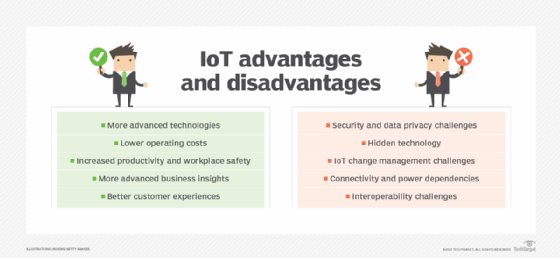Top advantages and disadvantages of IoT in business
Although the use of IoT in businesses is becoming increasingly popular because of the insights it provides, the technology comes with its own risks and challenges.
IoT has transformed how businesses operate by connecting devices, processes and people in new and innovative ways. It promises to enhance efficiency and productivity while making everyday operations more convenient. The global IoT market is projected to grow nearly 11% annually, as the deployment of other key technologies, such as 5G and cloud computing, continues to expand.
Some businesses that have adopted IoT, such as those in the healthcare and industrial sectors, have lowered their operating costs, gained new consumer insights and discovered innovative ways to optimize their operations. Others remain hesitant to use IoT due to perceived downsides, including security issues, interoperability concerns and additional infrastructure costs.
What are the advantages of IoT in business?
The potential upsides of IoT include the following.
1. More advanced technologies
IoT has evolved significantly in the last several years, making technology affordable for most use cases. The most significant leap has been adopting AI cybersecurity tools such as Darktrace, CrowdStrike Falcon and SentinelOne, which help identify real-time vulnerabilities to prevent cyberattacks.
Additionally, 4G/5G wireless networks will replace older 2G/3G ones in many settings, increasing the number of connected devices available. This will make deploying IoT networks at scale even more cost-effective, and businesses will enjoy a faster ROI.
2. Lower operating costs
A fleet of IoT devices can be cost-effective, as it helps businesses optimize workflows and lower operating costs by providing real-time information. These devices can be integrated into larger systems to enhance operational efficiency and help reduce costs. For example, smart building systems can track, monitor and control HVAC systems to optimize building usage and make adjustments to capitalize on lower time-of-use costs, thereby saving money.
Additionally, after several years of instability, prices for IoT components such as memory and storage have finally stabilized. This means that IoT manufacturers can produce devices more quickly and affordably, passing the savings on to customers seeking to expand their fleets.
3. Increased productivity and workplace safety
IoT devices can manage, monitor and alert staff to changes in processes or productivity, helping them make smarter decisions about their work. Engineers and ergonomists use the data to optimize each workstation, enabling more efficient movement and helping workers avoid injuries.
Companies can use IoT data to more effectively plan for downtime and maintenance, ensuring their most valuable assets operate at peak performance. Sensors in the machines track their lifespan more efficiently and can accurately predict when components will fail, which helps management schedule repairs and lifecycle updates during off-peak times.
4. More advanced business insights
IoT devices help organizations gather data to identify insights about their business, both internally and externally. Here are some examples:
- Retailers can use beacon technology and other IoT devices to redesign their stores based on real-time traffic patterns.
- Logistics firms can use internet-connected IoT to align delivery locations and schedules to make more efficient use of vehicles and employees.
- Farmers can use embedded crop and soil sensors to manage growth and spot potential threats such as insect infestations or dramatic environmental changes.
- Livestock producers can remotely monitor their animals and detect early signs of disease.
Businesses that use IoT to modernize their organizations can reduce the time it takes to bring new products or services to market and increase their ROI. They'll add value to the business faster and more efficiently because more actionable data from the devices is easily accessible.
5. Better customer experiences
IoT devices help businesses track, monitor, uncover and analyze customer data faster than before. Businesses can predict shifts or trends in customer behavior before they happen.
Advanced IoT technology can enhance the customer journey by personalizing it based on past experiences. Think of the location trackers on shipping vehicles or personalized coupons offered through a mobile app on customers' smartphones when they enter a store or business.
A smart home device, such as a refrigerator, washer or thermostat, can automate previously manual processes, including monitoring and maintenance. These devices can signal when a replacement is necessary, enabling manufacturers to launch preemptive marketing campaigns or free up consumers' time to run errands while their washer sends text updates on the cycle timing.
From a health perspective, smart devices that monitor heart rate, blood glucose and other vital signs are helping providers improve patient care and outcomes. People can opt into services that use their device data to recommend dietary supplements, workout routines and more -- all informed by their wearable device.

What are the disadvantages of IoT in business?
IoT presents several potential obstacles, however.
1. Security and data privacy challenges
Although cybersecurity is a high priority, IoT devices are often not included in the strategy. Devices must be protected from physical tampering as well as internet-based software, network-based and hardware-based attacks.
Data privacy is another concern, especially as IoT devices are increasingly used in sensitive industries such as healthcare and finance. Information privacy laws are also being adopted worldwide, which means that it's not only smart business practice to protect data; companies are legally required to do so. The data must be collected, stored and analyzed in compliance with data privacy and sovereignty laws, which are expensive to violate.
Integrating encryption and security measures with IoT devices can be challenging when managing a large fleet. The cost of time, effort and money to do it on all devices can be prohibitive, so some businesses might use inadequate systems because they're cheap -- or not use them at all. It only takes one breach for a business to learn a tough lesson.
2. Hidden technology
Although it might seem like IoT devices are performing simple tasks, such as counting entry swipes at a secure door, a lot of complex technology is involved.
If those IoT devices provide essential data to another workflow or system, they could negatively affect everything connected to it. Miscounting the number of swipes at the door isn't a big deal. However, if another system or device uses that incorrect data to do something else, like turning environmental controls on or off, there could be significant consequences.
There can be a big learning curve to deploying IoT devices in any business. It makes sense to develop a strategy on how and why to deploy them before adoption. That way, businesses can be assured that they're working as intended and can be easily supported.
3. IoT change management challenges
Companies often view IoT merely as a technology and overlook its implications for business processes. This means they usually leave implementation, maintenance and security exclusively to IT teams without regard to any legal, industry or internal team effects.
Truly realizing the value of IoT in a digital transformation project requires collaboration across teams and functions within a company. Management and subject matter experts must share requirements, needs and challenges to address all business aspects. They should identify essential features and gaps in processes that IoT devices can fill and determine where additional support is needed. Only through working together can companies change people's behavior, processes and procedures while also complying with legal and regulatory requirements.
4. Connectivity and reliability challenges
To function properly, IoT devices depend on continuous power, network and internet connectivity. Unstable power or connectivity can degrade IoT device performance, potentially interrupting operations for the devices and any downstream processes. Businesses in regions with poor internet infrastructure might find it challenging to fully adopt IoT and/or integrate it to the extent they wish to.
Fearing a connectivity outage can be a significant limitation for businesses, especially if the devices are integrated into mission-critical processes and infrastructure. Picture an outage during a remote surgery or the loss of routing information for a valuable delivery.
Businesses must understand how outages affect their devices to plan proactively for these events. An outage will inevitably occur at some point. Troubleshooting and incident management processes can help alleviate that, as can ensuring that employees know how to work when the devices are down.
5. Interoperability challenges
There's currently no consensus regarding IoT protocols and standards, so devices produced by different manufacturers might not be compatible with an existing tech stack. Each might require different configurations and hardware connections, making efficient deployment difficult.
Businesses must understand their network to prepare for any needed customization. That also means planning for extra time on device deployments to handle any troubleshooting or related tasks that might arise.
6. Ethical and social implications
The widespread adoption of IoT devices and their integration into various smart devices, such as wearables, home appliances and vehicles, raises several ethical questions -- namely, the idea of constant monitoring and surveillance.
IoT can enable near-constant monitoring of people, their activities, locations and more, which can make them uncomfortable. Knowing basic information about people while at work is one thing, but tracking them at home or in other public places where they have an expectation of privacy is another.
Businesses must balance IoT's capabilities with respect for individual privacy in personal and professional settings. This might involve limiting device functionality, restricting access to collected data and being transparent about how a business uses the data it collects.
Will AI affect IoT in business?
According to 91% of respondents to an IEEE survey, the answer is yes. Generative AI and large language models (LLMs) will drive IoT evolution as public fascination and perception shift. Business leaders are gaining a deeper understanding of what AI can do and how it could be integrated into IoT fleets and related technologies.
One area of IoT that might see more AI investment is in the component architectures of devices and the networks they connect to. For example, changes in storage and memory approaches will alter the way data is stored and processed in data centers and edge systems, resulting in reduced data movement and lower power consumption.
Additionally, there will likely be increased investment in data centers to handle and manage all the data processing from IoT devices and applications. Many facilities are already experiencing exponential growth due to the rapid expansion of AI and LLM technology, so adding IoT to the mix will likely increase this growth even further. It might also lead to more adoption of edge computing -- specifically for IoT devices and data -- to alleviate the load on data centers, or at least to cut down on the amount of data sent to data centers for more advanced processing.
Summary of advantages and disadvantages of IoT
IoT devices can be valuable to businesses today, but only if these businesses understand what they're getting into. Described above are just some of the benefits and drawbacks of IoT. Whether businesses are adding IoT devices for the first time and need to review security features and how they align with privacy guidelines, or they are looking to expand their fleet to meet increasing demand, IoT devices can help support the organization. With proper planning, organizations can better identify their needs, helping them make the best decisions for their business.
Julia Borgini is a freelance technical copywriter, content marketer, content strategist and geek. She writes about B2B tech, SaaS, DevOps, the cloud and other tech topics.







